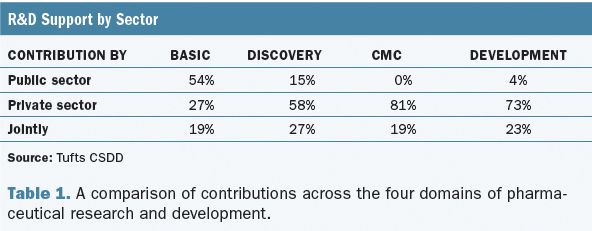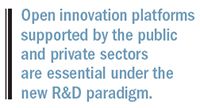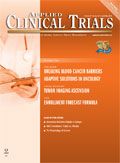Giving Pharma Credit for Medical Innovation
Applied Clinical Trials
Study shows that industry contributions to R&D go well beyond the applied area of clinical testing.
In late January 2015, Senator Elizabeth Warren (D-Mass) submitted a new bill to Congress called the Medical Innovation Act. The bill would require major pharmaceutical companies that are convicted of breaking the law to pay 1% of their annual profits for each drug they develop that can be traced to government-funded research. Warren estimates that the bill-if passed-would eventually deliver an estimated $6 billion each year in incremental support for the National Institutes of Health (NIH).

Kenneth A. Getz
Among the public and private sectors within the research community, this bill-more affectionately known as the "swear jar" bill-has stimulated debate about who should receive credit for medical innovation and whether additional investment in NIH-based research will have its intended impact. The bill has also stirred up the perennial and deep-seated misconception that drug discoveries come primarily from government-based research activity and that industry lurks about waiting to profit handsomely from discoveries paid for by public tax dollars.
A new study by the Tufts Center for the Study of Drug Development (Tufts CSDD) informs this debate and characterizes the highly interdependent relationship between public and private sectors that drives medical innovation. The results show that drug discovery through clinical development is supported by a complex community of contributors, including industry-academic partnerships, venture capital, disease foundations, public-private, and private-private pre-competitive consortia.
The public sector is the dominant contributor in basic research. But industry is the dominant contributor in discovery, manufacturing, lab and animal model testing, and in drug development.
The Tufts CSDD team also examined how much funding would be required from the NIH and other government sources to replace private sector contributions to new drug research and development. The team concluded that, conservatively, the NIH budget would have to increase by approximately two-and-half times to maintain the current volume of new treatments in development.
Methodology
The Tufts CSDD team analyzed 26 therapies deemed the most important and transformative drugs in healthcare over the past 25 years based on a survey of nearly 200 expert physicians from the top 30 U.S. academic medical centers. Tufts CSDD compiled in-depth case studies on these individual therapies; analyzed data from proprietary and commercial databases; conducted online searches; and reviewed published literature from professional journals, the trade press, textbooks, and historical reviews of drug origins. The study scope was expansive, requiring an assessment of global R&D activity spread out over an average of 25 years from discovery to approval.
Contributions to various drug development milestones were mapped for each therapy including: disease process, drug target, mechanism of action, drug concept, isolation and purification, synthesis and early testing, patenting, lead optimization, preclinical studies, formulation and manufacturing protocols, clinical development, approval, and launch. Contribution assessment was then organized around four largely sequential R&D domains or categories-basic research, discovery, chemistry/manufacturing & formulation/controls (CMC), and development. Multiple team members conducted independent reviews of the contribution assessments to reach a consensus assessment.
For the economic analysis, the Tufts CSDD team used a methodology it has developed, validated, and applied for decades to determine the total out-of-pocket R&D costs to develop each therapy. NIH budget figures were gathered from publicly available sources.
Credit where credit due
The results indicate that the private sector is the dominant contributor in three out of the four primary R&D domains. And of the 26 major therapies evaluated, only four (15%) appear to have been almost completely researched and developed by the private or public sector alone. All others involved a high level of collaboration and shared contribution.
The table indicates the contribution of the public and private sectors across the four R&D domains.

Table 1. A comparison of contributions across the four domains of pharmaceutical research and development.
The public sector dominated the basic science domain. More than half (54%) of the basic science milestones were achieved largely by the public sector. More than one-quarter (27%) of the basic science milestones were achieved by the private sector. Contribution to the basic science milestones by one sector over another was indiscernible for nearly one-out-of-five therapies.
In the discovery domain, the private sector was the dominant contributor. The private sector made the dominant contribution to achieving discovery milestones for 58% of the therapies. Approximately one-out-of-seven (15%) of the discovery milestones was achieved by the public sector.
The private sector also made the dominant contribution to achieving CMC and drug development milestones. The private sector was the dominant CMC contributor on the vast majority of therapies (81%). Approximately 20% had no discernible dominant contribution. And the private sector was the dominant contributor to achieving development milestones for 73% of the innovative therapies. This compares with the public sector serving as the dominant contributor in the development phase on 4% of the therapies.
With respect to the economic analysis, the Tufts CSDD team determined that the total aggregate out-of-pocket cost for the most innovative drugs developed between 1987 and 2002 was $128 billion (in year 2013 dollars). On an average annualized basis, this amounts to about $8 billion in aggregate costs. R&D activity typically continues long after a drug has received approval to support testing of new dosage levels, new formulations, new indications, and to meet regulatory post-marketing commitments. Tufts CSDD determined that an additional $41 billion was spent on the most innovative therapies for post-approval R&D activity. The total aggregate lifecycle R&D costs for the most innovative therapies came to $169 billion or an average annual aggregate cost of $10.6 billion per year.

Based on its annual expenditures, the NIH would have to have nearly doubled its budget to replace industry contribution to develop the most innovative therapies. These estimates are very conservative. The level of NIH support required to replace industry contribution would no doubt be substantially higher; the estimates are based on the cost to develop therapies during the 1987 to 2002 period. These costs have increased dramatically due to many factors, including increased scientific and operating complexity associated with more demanding disease conditions and regulatory requirements. In addition, the NIH's relative inexperience in managing later stage R&D activity would likely drive R&D costs higher than those borne by industry.
Conducive to collaboration
The commonly held belief that the private sector adds limited value but reaps huge profit on the hard work and tax-supported backs of the public sector research community is simply a myth. Far from being exploitive bystanders, pharmaceutical, biotechnology, and medical device companies make substantial contributions.
The Tufts CSDD study demonstrates that industry contributions go well beyond the applied area of clinical testing; the private sector plays an integral and essential role in translating knowledge about biological processes into a medicine or vaccine providing clinically meaningful benefit at minimal risk. The replacement of private sector contribution by the public sector is completely unrealistic. Even more compelling, the absence of private sector contribution to medical research would render the return on taxpayer investment in the basic sciences largely inconsequential.
Public-sector funding for medical research continues to face significant constraints. Pressures from patient communities and the healthcare environment are growing. As a result, demand for private sector contribution and collaboration with academia and government will continue to intensify.
Open innovation platforms supported by the public and private sectors are essential under the new R&D paradigm defined by patient community engagement. These platforms will be the most effective when medical research stakeholders are best informed about, and acknowledge, the contributions that each sector-and each collaborative partner-brings to advancing public health.
To review a detailed report on the Tufts CSDD study, go to: http://csdd.tufts.edu/files/uploads/PubPrivPaper2015.pdf.
Kenneth A. Getz MBA, is the Director of Sponsored Research at the Tufts CSDD and Chairman of CISCRP, both in Boston, MA, e-mail: kenneth.getz@tufts.edu
